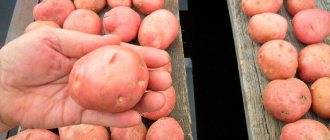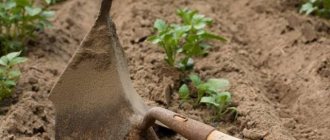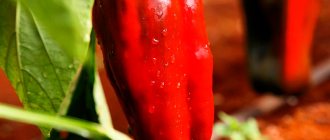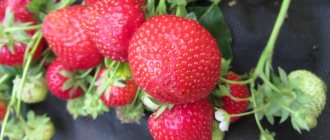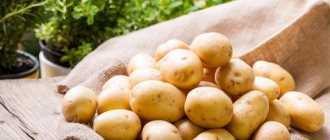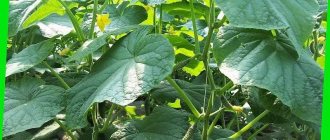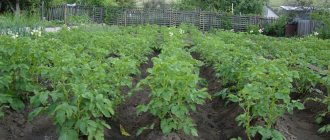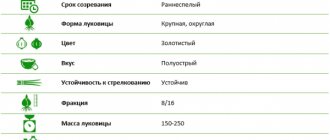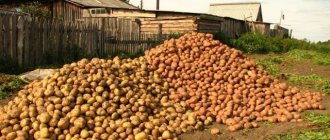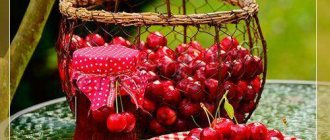Description of the potato variety Krasavchik
The Krasavchik potato belongs to the productive varieties of medium-early ripening. Potato bushes are erect and low. The leaf blade is green, slightly corrugated along the edges. The variety blooms with whitish-pink flowers with a yellowish anther.
According to the description, the potato tubers of the Krasavchik variety are oval-shaped, even, as can be seen in the photo, and smooth to the touch. The peel color is light pink. The eyes are small, but there are quite a lot of them. The pulp of the tubers is creamy.
The average weight of the fruit is 150-160 g. Potatoes ripen in 85-90 days from the moment the first shoots appear.
Characteristics of the bush and fruit
The bush looks medium in size. Its shape is semi-erect. It is covered with medium-sized green leaves. They have no pronounced wavy edges. The inside of the flower corollas is covered with a barely noticeable blue. Other characteristics:
- starch content level: 12.5 – 19%;
- smooth mesh peel color: red;
- pulp: creamy-cream color;
- medium-sized oval tubers;
- Oval-round tubers are less common;
- tuber weight: from 90 to 160 g;
- number of tubers in a bush: up to 11;
- corolla color: pale blue.
The surface of the tubers is dotted with small “eyes”. They lie at shallow depths.
Characteristics of the “Krasavchik” potato
Potatoes "Krasavchik" belong to the mid-early varieties, since from the emergence of seedlings to the full ripening of the crop, it usually takes from 80 to 90 days.
It was included in the State Register of the Russian Federation for cultivation in the Central Black Earth region, and also became widespread in Moldova and Ukraine.
The “Krasavchik” potato variety tolerates drought and mechanical damage relatively easily, and is also characterized by resistance to diseases such as banded and wrinkled mosaic, late blight and the causative agent of potato cancer, but is susceptible to golden cyst nematode.
The ability to store well is an important quality for potatoes. In the table below you will find this characteristic for different varieties:
| Variety name | Keeping quality |
| Handsome | 97% |
| Timo | 96% |
| Arosa | 95% |
| Spring | 93% |
| Vineta | 87% |
| Impala | 95% |
| Zorachka | 96% |
| Kamensky | 97% |
| Latona | 90% |
| Lyubava | 98% |
| Luck | 88-97% |
Read more about the storage time and temperature of potatoes, and about possible problems. And also about how to properly store potatoes in winter, on the balcony, in boxes, in the refrigerator, peeled.
This variety should be planted after annual and perennial grasses, winter and leguminous crops, as well as flax. In sandy soils it can grow after lupine. The pH acidity of the soil for optimal growth of this vegetable should be 5.0–5.5 units, and if necessary, the soil should be limed.
Potatoes of this type are characterized by semi-erect bushes of medium height, having an intermediate type of growth. They are covered with green leaves of medium size, differing in the intermediate type. On the inside of the corolla you can notice an anthocyanin color of medium intensity, in which blue is almost completely absent or is very insignificant.
Pests and diseases
Potato Handsome has good immunity to the following diseases:
- striped and wrinkled mosaic;
- potato cancer.
The culture shows average immunity to late blight on the tops. The variety is not resistant to potato nematode, as well as late blight on tubers. Therefore, summer residents recommend following standard prevention rules. Handsome potatoes should not be planted in a field where there were other varieties or tomatoes before. After three years of cultivation, the field must be changed.
When the tops grow to 20 cm, they are treated with a fungicide:
- "Prestige";
- "Home";
- "Quadris";
- "Maksim";
- "Fitosporin";
- Bordeaux mixture.
You can get rid of insects using folk remedies. For example, Krasavchik potato bushes can be periodically dusted with wood ash, the plantings mulched with sawdust, and the rows watered with a solution of birch tar. The bushes themselves are treated with a decoction of marigolds, an infusion of garlic, chili pepper, mustard powder and other means.
In case of pest invasion, resort to insecticides:
- "Green Soap";
- "Agravertine";
- "Spark";
- "Colorado";
- "Fufanon" and others.
If the Krasavchik potato has suffered from late blight, it is better to dig it up and destroy it so as not to infect neighboring bushes
Attention! Next to the field where the Handsome potatoes grow, it is advisable to plant calendula, fragrant tobacco, coriander, marigolds and other herbs with a specific aroma that repels insects.
Pros and cons of the Krasavchik potato variety
The advantages of the Krasavchik potato variety include the following characteristics:
- resistance to many diseases that are typical for potatoes;
- undemanding to soil composition;
- high starch content;
- excellent taste;
- possibility of long-term storage;
- attractive appearance;
- resistance to heat;
- drought resistance;
- high yield rates;
- versatility of using tubers;
- resistance to mechanical damage.
The disadvantages of the Krasavchik variety include vulnerability to the golden nematode, however, this is a rather controversial point. If the area is treated with insecticides in a timely manner, this pest does not affect potatoes. In addition, the disadvantages sometimes include the fact that the tubers do not soften during cooking.
Description and characteristics
This potato variety was bred in 2009 by Russian breeders from the Potato Research Institute named after. A. Lorch and was originally intended for cultivation in the Central Black Earth economic region. However, Handsome quickly spread to many other regions of the country and even beyond its borders.
This potato plant is a semi-erect bush of medium height, covered with medium-sized green foliage. The tubers are oval in shape and reddish in color with pink flesh inside. Small eyes make it easier to peel the tubers, and the density of the pulp contributes to good transportability of the potatoes. The mass of tubers varies between 90 and 165 g.
Did you know? In addition to traditional potatoes with white or yellow flesh, there are varieties with red, black and even blue flesh.
Taste qualities
With a high starch content reaching 17.8%, the tubers retain their original shape during any heat treatment and are suitable for:
- cooking;
- frying;
- extinguishing;
- making French fries;
- use in salads and soups;
- baking;
- making puree.
The flesh of Krasavchik does not darken during heat treatment and has high taste qualities.
Ripening time and yield
Reaching the technical maturity phase after 80-90 days of the growing season, the Krasavchik potato belongs to the mid-early varieties. Moreover, its yield, depending on the region of growth and the conditions created for this, ranges between 170 and 200 c/ha, sometimes reaching over 280 c/ha. On average, with proper care, the Krasavchika bush produces up to 5 kg of full-fledged fruits.
Taste qualities of potatoes
The pulp of the Krasavchik potato variety is dense and juicy, and the taste of the tubers is highly rated. The variety is classified as a high-starchy variety - the starch content in the fruit reaches 17-18%.
When to sow and harvest Lupine, planted as green manure to improve soil fertility
Heat treatment does not cause darkening of the tubers. In addition, after cooking the potatoes do not become soggy. The variety is used to prepare dry mashed potatoes and French fries. The tubers are also suitable for frying when peeled, cooking potatoes in their jackets (the skin of the Krasavchik variety does not crack when exposed to high temperatures) and baking. Due to the fact that the Krasavchik variety retains its shape well, the tubers are added to soups and salads.
Characteristics of the variety
Bush
Main external signs:
- low-spreading;
- low;
- ordinary sheet, intermediate type;
- the flower corolla is white and pink, with a barely noticeable bluish tint;
- the shape of the tubers is oval;
- ocelli multiple, but small;
- the peel is dense, smooth, dark pink;
- the pulp is creamy;
- tuber weight – from 90 to 166 g.
- starch about 17.8%.
Productivity and taste
Here's what Handsome can deservedly boast of:
- mid-early variety;
- the growing season lasts from 80 to 90 days;
- marketable yield reaches 201 c/ha, maximum – 284 c/ha;
- with proper agricultural technology and favorable weather conditions, you can get up to 5 kg of tubers from a bush;
- marketability reaches 98%;
- keeping quality no less than 97%;
- the taste is good and excellent;
- does not boil over.
Potatoes will be “ready” 60-80 days after germination, and in small farms it is possible to dig up large root crops as early as a month and a half.
Resistance to negative external factors
The Krasavchik potato survives short-term drought without problems. Therefore, it compares favorably when assessing the yield in dry years.
Therefore, during loading, unloading and transportation, Handsome is not damaged, maintaining its presentation. During storage, whole tubers are not affected by rot.
Resistance to diseases and pests
Potato Handsome is confidently resistant to the threat:
- late blight;
- potato cancer;
- wrinkled and striped mosaic.
Resistant to other troubles, but powerless against the golden cyst nematode.
Growing
It is recommended to grow potatoes in areas where the following were previously grown:
- linen;
- leguminous plants;
- herbs.
For better development of such potatoes, the pH acidity of the soil should be at the level of 5.0–5.5 units and therefore, if necessary, it is worth liming the soil.
Tubers are planted at a distance of 30–40 cm from each other. The distance between the rows is 50–60 cm. The soil for planting is prepared in advance and allowed to warm up, and only then the potatoes are planted. If the soil is warm, then the sprouts will germinate faster and the formation of potato tubers will begin.
Watering Krasavchik potatoes should be done at the root, since irrigating the tops does not make sense. During planting, it is recommended to add complex fertilizer to the holes. In order for the plant to gain green mass as soon as possible and begin to devote more energy to the formation of tubers, it is recommended to water it with special growth stimulants. They are absolutely safe for both the plant and the gardener.
Potatoes of the Krasavchik variety can be planted in the same area only with an interval of three years.
Features of cultivation
Considering the “dampness” of the material, we can say that the agricultural technology of colored potatoes is no different from the agricultural technology of the familiar, one might say, native light potato. Like light potatoes, colored ones are watered 3-4 times (in normal summers) and twice as often in dry ones.
It is important that abundant watering does not turn into excessive: this can reduce the shelf life of the root crop, especially if the potato beds are shaded by the garden
When dealing with small root tubers, there is a temptation to save soil, but this is wrong.
Close planting, in a row of 20 cm, is normal for planting potatoes from seeds or planting seedlings from seeds, also from seeds. Commercial (for food) potatoes need to be planted 30 cm and 70 cm apart between rows, or in paired rows 30x40x30 apart.
There are many ways to plant and process tubers - try them and you will find the best one for yourself.
The yield and size of tubers largely depends on the land, but size rarely matters - the main thing is that the potatoes are treated less often with chemicals.
There is an old method that allows you to make a potato variety more productive. Breeder Alexey Med talks about it at FORUMHOUSE. According to him, in Russian villages they always exchanged seeds, and it was desirable that the one with whom you exchanged lived somewhere far away. This method is called the “first year effect” and is still used in modern experiments by scientists.
The fact is that in the first year on the plot, potatoes almost always produce a harvest of better quality than in subsequent years. This happens for a number of reasons.
What causes the “first year effect”
- other food;
- different soil structure,
- other infestation with diseases and pests.
Good potato harvests come in waves, along a chain: your neighbor got good seeds of a new variety, you took them for the next year, so your neighbor had a good harvest this year, you had a good harvest next year, and so on. Therefore, the value of a variety is determined, among other things, by what it shows in the second and subsequent years of cultivation.
This method can be used by alternating where to plant potatoes, especially if you have a large area with different types of soil.
My potatoes grew on clay, they were bad, but when they were transferred to well-developed sands they gave a phenomenal harvest throughout the year. I used it like this for 6 years, but it continued to be no good on clay (unlike other varieties).
Landing rules
Before planting, the tubers can be treated with growth stimulants.
The Krasavchik variety cannot be planted in the same place every year. Re-planting is carried out only after 3 years. During disembarkation, you must follow simple recommendations.
- Handsome loves a lot of light, so it should fall evenly over the entire area. To do this, it is planted from north to south.
- It is worth paying attention to the acidity of the soil, it should be 5.0-5.5. If the acidity is not the same, then liming is necessary.
- Be sure to dig up the soil in the fall. The depth should be 25-30 cm.
- After digging, 300 kg of manure and 1 kg of wood ash are added to the soil.
- Only healthy and high-quality tubers are planted. But first, the tubers are heated, germinated and left to bask in the sun for a while.
- An excellent result is shown by the amount of harvest if the fruits are treated with a growth regulator before planting. For this, use “Epion” or “Zircon”.
- In order for the buds on the fruit to begin to germinate quickly, a large transverse incision is made.
How to harvest and store crops
Harvest begins in August (specific dates vary by region). Tubers that have entered the stage of technical maturity are almost impossible to damage. They are dug out with a shovel or pitchfork and left on the bed to dry.
You need to dig up potatoes in dry weather so that the fruits are not wet and do not begin to rot. After 2-3 days, you can send the potatoes for permanent storage.
Storage features and keeping quality of the Krasavchik variety
The room where the Handsome potatoes will be stored should be dry, dark and well ventilated. The temperature in it should not be high. For storage, it is better to choose simple wooden boxes. Keeping quality and presentation under proper storage conditions are preserved by 97%.
How to properly care for potatoes
Proper and timely care will make it possible to obtain a large and high-quality harvest. Be sure to carry out fertilizing, loosening, removing weeds and watering. If there is a need, then irrigation procedures are carried out, which will have a great effect on growing potatoes in any soil.
The procedures that are necessary for proper care of potatoes are no different from the standard procedures of any other type. The soil for potatoes must be fertilized and fertilized.
- Many gardeners advise feeding the plant once with mullein or bird droppings. The droppings are diluted in water at the rate of 1-2 liters of mixture per 1 bush.
- High-quality manure is added just before planting, under the plant. Such an event will help increase productivity several times. Fertilizing can also be done after planting.
- When flowering comes to an end, foliar feeding is applied. It shows good results, as it comes along with phosphate fertilizers.
- Fertilizers containing nitrogen can be applied, but together with potassium. Do not use large amounts of wood ash.
Callisia (Golden mustache), (Callisia). Description, types and care of callisia
Recommended agricultural technology
The variety requires moderate watering between rows. Complex mineral fertilizers are regularly applied. They should contain elements such as nitrogen, potassium, phosphorus. Optionally, the listed substances are replaced with organic matter, loosening the soil, and hilling. Other care recommendations:
- the seed is placed on the bed from north to south;
- potatoes need even lighting;
- remove weeds regularly;
- Apply up to 1.5 liters of water per bush;
- feeding is carried out with mullein;
- a day before placing the planting material in the hole, place a teaspoon of manure there to accelerate the growth of tubers;
- phosphorus fertilizers are applied foliarly immediately after flowering;
- nitrogen, potassium and potassium fertilizers are applied simultaneously;
- Wood ash is not used in the garden bed.
On a note! The distance between bushes is at least 60 cm, and between rows - at least 30 cm. Seeds are immersed in the soil to a depth of 10 cm. Failure to comply with these values increases the likelihood of pathogens appearing on seedlings.
Care
Krasavchik potato seedlings are regularly cleared of weeds and the soil is carefully loosened. Watering is carried out when there is abnormally dry spring weather. Potatoes especially need to moisten the soil to the depth of old tubers, when buds form and after flowering. It is not recommended to water the plantings until the stems reach 10-12 cm. 3-6 liters of water are consumed per bush, in hot weather the volume increases to 12-20 liters. Irrigation affects not so much the number of ovaries as the size of the tuber.
Hilling and feeding
Hilling the bushes two or three times will have a positive effect on the harvest. Spud up with dried but still damp soil after watering or rain. The first time the height of the ridge is up to 12 cm, the next time – up to 20 cm. It is recommended to hill the bushes on both sides, without pouring soil into the center of the bush.
They begin to fertilize the Krasavchik potato variety when the plants reach a height of 15 cm: with urea, mullein or chicken droppings. Before flowering, feed with wood ash or potassium sulfate, and after - superphosphate.
Planting and growing
The plant is considered unpretentious in care, but without proper preparation of the seed material, you can lose part of the harvest.
Pre-sowing preparation
Tubers are prepared for planting a month in advance. During this time they need to be germinated and greened. The weight of planting tubers should not exceed 100 g.
After careful inspection, the seed material is laid out in a bright room at a temperature of +15...+17°C. Lower temperatures lead to the formation of brittle sprouts.
Reference . Before germination begins, those sprouts that formed during storage are removed.
Immediately before planting, the seed is treated with a growth stimulant and Fitosporin, which protects against fungal spores. Stimulants used include Epin or Kornevin.
Soil requirements
For planting Krasavchik potatoes, it is best to choose open sunny areas - they are thermophilic.
Soil acidity should not exceed 5.5 units. If the indicator is elevated, the soil is deoxidized using dolomite flour or slaked lime. Litmus paper will help determine acidity. Dissolve a little earth in a glass of water and place an indicator. Red color means increased acidity.
Reference. Plants on the site will help determine acidity. The appearance of sorrel, blueberries or lupine indicates an acidic environment.
To increase the fertility of the soil, it is dug up twice with the addition of ash and humus. The first digging is carried out in the fall, after harvesting, the second time in the spring, before sowing.
Dates, scheme and rules of planting
Optimal time for planting potatoes: late April - early May . The main factors to focus on are air and soil temperature. Tubers are planted as soon as the soil warms up to +9...+11°C, and the soil temperature stabilizes at +16...+19°C. In cold regions, this temperature regime is reached no earlier than the end of May.
The seed is planted at a distance of 30 cm from each other. The width of the rows is at least 60 cm. The depth of the holes is 8-10 cm. Before sowing, no more than 50 g of wood ash is placed at the bottom of each hole.
Features of cultivation
Crop care is based on conventional agricultural practices: watering, fertilizing, loosening, weeding and hilling.
Watering mode
Watering begins after the bushes grow to 10-15 cm. A large amount of moisture is needed only during flowering, when the formation of tubers begins. For each seedling, at least 4-6 liters of water are consumed; in severe drought, the volume is increased to 10-12 liters.
Lack of moisture during tuber formation leads to a decrease in their size.
Feeding
Fertilizing begins when the seedlings are 15-20 cm high. For the first fertilizing, organic matter is used - bird droppings or mullein infusion in a ratio of 1:10 . For each seedling, 2 liters are consumed.
During flowering, the crop is fertilized with a complete mineral complex, focused on phosphorus.
During fruiting, potassium is added in combination with nitrogen.
Reference. All fertilizing is carried out on abundantly moist soil. Timely application of fertilizers significantly increases productivity.
Loosening and hilling
Loosening improves oxygen access to the roots, which is necessary for seedlings to fully develop. Loosen the beds after watering. Then they are weeded and mulched. Mulch, such as straw or peat, prevents new weeds from growing and retains moisture.
Hilling is carried out on damp soil - after watering or rain. The bushes are earthed for the first time when they are 20-25 cm tall. The ridge is made no lower than 10 cm. Hilling protects the tubers from sunlight and pests. The second time, the ridge is raised to 20 cm. The seedlings are hilled on both sides, without filling the center.
Disease and pest control
Potato diseases are rare, but the variety is defenseless against the golden nematode. These are small pest worms, from whose vital activity the foliage dries out and flowering does not occur. To avoid their appearance, it is necessary to dig up the soil twice - during digging, adult individuals and their larvae are destroyed.
In order to prevent nematodes, planting tubers are treated with the preparation “Gumi” or “Albit”, and the area before sowing is treated with urea at the rate of 1 kg per 10 square meters. m. Also, the golden nematode is afraid of the smell of certain plants - marigolds, sweet clover and calendula.
The mole cricket and the Colorado potato beetle are especially dangerous for potatoes. Preventive measures in the fight against mole crickets are carried out in advance. Almost immediately after planting the tubers, Medvetox granules or crushed garlic cloves are buried in the ground. The smell repels the pest, and it does not approach such beds.
A thorough inspection of the seedlings helps to notice the Colorado potato beetle in time. The Colorado potato beetle is dangerous because it destroys crops in a short period of time. To combat it, appropriate insecticides are used, for example, “Prestige”.
Difficulties encountered during cultivation
Subject to the rules of crop rotation, soil fertility and plant health are maintained. In addition, compliance with established standards increases crop productivity.
Potatoes are planted in beds where carrots, onions, cabbage, legumes and winter crops previously grew. Potatoes are not planted after crops from the nightshade family, as these plants greatly deplete the soil.
If you plant marigolds between potato seedlings, you can scare away nematodes and whiteflies from the beds. In the fall, the soil is dug up along with these flowers, and worms will not appear in the ground.
Diseases and pests
The Krasavchik variety is resistant to the following diseases:
- late blight;
- striatal mosaic virus;
- wrinkled mosaic virus;
- potato cancer.
The variety rarely gets sick, however, potatoes are vulnerable to pests such as the golden nematode. The first sign that the bushes have been infected by a nematode is the rapid drying out of the leaves, bending of the stems and lack of flowering. The root system of the bushes darkens, and the tubers become very small.
The pest is controlled using the drug "Tiazon", however, it is quite toxic. To avoid harm to health, future beds are processed at least a month before potatoes are planted in the ground.
Advantages and disadvantages
This variety has many advantages. Handsome has a wide growing area, so it is used for planting in different soils. The keeping quality of the variety reaches 97%, and the commercial characteristics up to 98%.
This type of root vegetable is often chosen by housewives due to its taste and resistance to heat treatment.
This potato has high resistance to many diseases, such as cancer and potato mosaic.
For a description of the rules for planting potatoes of the Krasavchik variety and photos, see below.
Potatoes of the “Krasavchik” variety can be characterized as follows:
- wide growing area;
- high yield of 170–202 c/ha;
- high commercial characteristics (marketability up to 98%);
- keeping quality is 97%;
- good taste and high quality tubers;
- demand as a raw material for processing;
- The variety is resistant to diseases such as wrinkled and striped potato mosaic and cancer.
A few disadvantages include the susceptibility of potatoes to golden cyst nematode. The description of the originator, as well as the main characteristics of the variety, suggest the resistance of the tubers and the average resistance of the tops to late blight.
The only drawback of the root crop of this variety is its susceptibility to the golden cyst nematode. The tops also have average resistance to late blight.
The main advantages include:
- Wide growing area;
- High yield;
REFERENCE: Proper care allows you to harvest up to five kilograms from one bush.
- High marketable appearance of tubers (up to 98%);
- Excellent keeping quality - 97%;
- Good taste;
- Demand as a raw material for processing;
- Immunity to wrinkled and streaky potato mosaic, cancer.
A minor drawback is that it is not resistant to the golden cyst nematode.
Reviews about the variety
First and second courses are prepared from this variety; it can be processed into French fries, and also used as a raw material for dry mashed potatoes. Vegetable growers speak positively about the quality characteristics and yield indicators of the “Krasavchik” variety.
The most delicious and productive potato varieties:
A big plus when choosing seed for a personal plot is the variety’s unpretentiousness in care. Many people do not have the necessary amount of time for timely care of potato plantings, but the correctly selected tasty and undemanding variety “Krasavchik” allows you to get an excellent harvest.
Harvesting and storage
The Krasavchik variety is harvested from August to September. A fairly common mistake among summer residents is early harvesting. Fearing the onset of premature frosts, gardeners dig up tubers much earlier than expected, as soon as the tops wither. The Handsome variety should remain in the ground as long as possible, since this determines how long the possibility of its storage will subsequently extend.
It is recommended to dig up the crop for storage when the potatoes have formed a sufficiently dense peel, that is, upon reaching the technical maturity phase. In this state, the tubers are less vulnerable to external influences.
The collection of root crops is carried out in cloudless weather - with the onset of rain, the tubers may be affected by wireworms during harvesting. Ultimately, most of the tubers may rot. In addition, wet soil sticks to the fruit, which increases the risk of infection by harmful microorganisms.
Features of further care
Caring for Handsome is required in a minimal amount and is no different from caring for other varieties. If the soil is fertilized, watered as needed, hilled and weeded, then you can count on a large, high-quality harvest. The following procedures must be carried out:
- weed the soil to remove weeds, hill up with damp soil when the tops reach 12-15 cm. Hilling up is carried out from all sides, raking the soil to the center of the bush;
- water the plantings during periods of drought. One bush should require at least 3-4 liters of water. Watering is especially important during flowering and ovary formation;
- Fertilize the soil as soon as the potato tops reach a height of 10-15 cm. You can use urea, mullein, wood ash, potassium sulfate and other substances. The total number of feedings should not exceed 3 times;
- treated against pests and diseases. Since the variety is vulnerable to late blight, potato bushes are treated with chemicals such as Ridomil, Acrobat, Tattu and others. You can use traditional methods; they are as effective as store-bought products. Insecticides will help against insects.
Handsome reaches the technical maturity phase in the second half of summer. You can try the first tubers from mid-July or even earlier, but you should not completely dig up the entire crop at this time. The skin on the fruit is still very thin, which means that such a vegetable cannot be stored for a long time and will quickly deteriorate. It is better to completely dig up the crop closer to the beginning of August. When the tubers ripen, the tops will turn yellow and bend to the ground. At this time, you need to cut it off, and then after a couple of weeks start digging.
Potatoes are harvested in sunny weather, since the fruits must dry well before the final harvest for storage. The dug up dried vegetables are sorted by size, discarded from diseased and damaged fruits, then placed in wooden boxes with slots or packed in bags and stored in a basement, cellar, closet, veranda, etc.
It is important to know whether it is possible to cut off the tops of potatoes after flowering.
